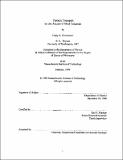| dc.contributor.advisor | Earl S. Marmar. | en_US |
| dc.contributor.author | Christensen, Cindy R., 1959- | en_US |
| dc.date.accessioned | 2005-08-19T19:31:37Z | |
| dc.date.available | 2005-08-19T19:31:37Z | |
| dc.date.copyright | 1999 | en_US |
| dc.date.issued | 1999 | en_US |
| dc.identifier.uri | http://hdl.handle.net/1721.1/9695 | |
| dc.description | Thesis (Ph.D.)--Massachusetts Institute of Technology, Dept. of Physics, 1999. | en_US |
| dc.description | Includes bibliographical references. | en_US |
| dc.description.abstract | A visible continuum array diagnostic has been constructed to perform experiments on the Alcator C-Mod tokamak. It views plasma Bremsstrahlung in a narrow spectral region free from atomic lines. Signals from thirty chordal views on the midplane are digitized and then Abel inverted to obtain emissivity as a function of minor radius. A procedure based on Green's functions was developed to deal with the problem of noise inherent to Abel inversion. It has a demonstrated ability to pick out the original signal from among noise of equal magnitude. Bremsstrahlung intensity is proportional to the square of electron density times "Z effective", which is a measure of impurities. In conjunction with an independent density diagnostic, the continuum array gives time-resolved impurity density profiles. Alternatively, when it is known that Z~1, the array gives electron density profiles with excellent time and space resolution and coverage of the plasma. An eigenfunction expansion method was used to obtain highly accurate solutions to the transport equation, using posited values of diffusion and convection coefficients and matching the data at the initial time and at the edge of the analysis region. The method assumes the simplest model of constant diffusion and convection linear in r, both constant in time. Possible values of coefficients are systematically scanned to find the best fit to the data. The fits are excellent, which justifies the model. A formal error analysis is done. Impurity injections are analyzed. It is shown that the transport of light elements can be analyzed in the core without the need for diagnostic beams. The elemental composition need not be known. A new electron transport regime was investigated. It is sometimes entered into at the ends of shots when the current is being ramped down. It features a small core plasma and greatly enhanced inward transport, producing very high density. Its potential as a tokamak operational scenario is unclear. | en_US |
| dc.description.statementofresponsibility | by Cindy R. Christensen. | en_US |
| dc.format.extent | 184 p. | en_US |
| dc.format.extent | 9878250 bytes | |
| dc.format.extent | 9878007 bytes | |
| dc.format.mimetype | application/pdf | |
| dc.format.mimetype | application/pdf | |
| dc.language.iso | eng | en_US |
| dc.publisher | Massachusetts Institute of Technology | en_US |
| dc.rights | M.I.T. theses are protected by copyright. They may be viewed from this source for any purpose, but reproduction or distribution in any format is prohibited without written permission. See provided URL for inquiries about permission. | en_US |
| dc.rights.uri | http://dspace.mit.edu/handle/1721.1/7582 | |
| dc.subject | Physics | en_US |
| dc.title | Particle transport on the Alcator C-Mod tokamak | en_US |
| dc.type | Thesis | en_US |
| dc.description.degree | Ph.D. | en_US |
| dc.contributor.department | Massachusetts Institute of Technology. Department of Physics | |
| dc.identifier.oclc | 42624060 | en_US |

